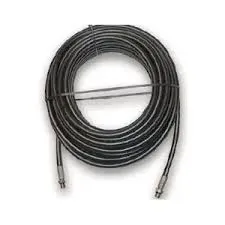Choosing the Right Power Steering Hose for Your Vehicle's Performance
Understanding Power Steering Hoses A Critical Component of Automotive Steering Systems
Power steering is an essential feature in modern vehicles, offering drivers enhanced control and ease of maneuverability. At the heart of this system lies the power steering hose, a vital component that plays a significant role in ensuring the effectiveness and reliability of power steering mechanisms. In this article, we will explore the function of power steering hoses, their types, common issues, and maintenance tips.
Function of Power Steering Hoses
Power steering hoses are responsible for transferring hydraulic fluid between the power steering pump and the steering gear or rack. This hydraulic fluid creates the necessary pressure to assist in steering, making it easier to turn the vehicle, especially at low speeds. The smooth operation of these hoses ensures that the power steering system can effectively reduce the effort required to steer, providing a more comfortable driving experience.
Types of Power Steering Hoses
There are generally two types of power steering hoses high-pressure hoses and return hoses. High-pressure hoses, as the name suggests, are designed to withstand the intense pressure generated by the power steering pump, which can exceed 1,500 psi. These hoses are typically constructed from durable materials, such as reinforced rubber or synthetic composites, to prevent leaks and ruptures.
Return hoses, on the other hand, transport the hydraulic fluid back to the pump after it has assisted in steering. While these hoses operate under much lower pressure, they still need to be robust enough to handle the effects of heat and wear over time. Both types of hoses are essential for the optimal performance of the power steering system.
an power steering hose

Common Issues with Power Steering Hoses
Like any automotive component, power steering hoses can encounter issues that may affect the performance of the steering system. One of the most common problems is fluid leaks, which can stem from cracks, abrasions, or wear and tear of the hose material. A leaking hose can lead to a drop in hydraulic pressure, resulting in reduced steering assistance and creating a potentially dangerous driving situation.
Another issue is hose bulging or swelling, often caused by exposure to extreme heat or incompatible fluids. This condition can compromise the integrity of the hose, increasing the likelihood of rupture. Drivers may also experience symptoms such as whining noises from the steering system or difficulty in turning the steering wheel, indicating that the power steering system is not functioning properly and may require hose inspection or replacement.
Maintenance Tips
To ensure the longevity and functionality of power steering hoses, regular maintenance is crucial. Exploratory inspections of the hoses for any signs of wear, cracks, or leaks should be part of routine vehicle checks. Additionally, replacing old or damaged hoses promptly can prevent costly repairs and ensure safety on the road.
It is also essential to use the correct type of hydraulic fluid recommended by the vehicle manufacturer, as using incompatible fluids can adversely affect the hoses' integrity. Keeping the power steering fluid at the correct level and changing it as per the manufacturer’s guidelines will further enhance the lifespan of the power steering hoses.
In conclusion, power steering hoses are indispensable components of a vehicle's steering system, contributing significantly to driving comfort and safety. Understanding their function, recognizing potential issues, and adhering to proper maintenance practices can help ensure that your vehicle’s power steering system operates optimally, allowing for a smoother and safer driving experience.
-
Ultimate Spiral Protection for Hoses & CablesNewsJun.26,2025
-
The Ultimate Quick-Connect Solutions for Every NeedNewsJun.26,2025
-
SAE J1401 Brake Hose: Reliable Choice for Safe BrakingNewsJun.26,2025
-
Reliable J2064 A/C Hoses for Real-World Cooling NeedsNewsJun.26,2025
-
Heavy-Duty Sewer Jetting Hoses Built to LastNewsJun.26,2025
-
Fix Power Steering Tube Leaks Fast – Durable & Affordable SolutionNewsJun.26,2025

